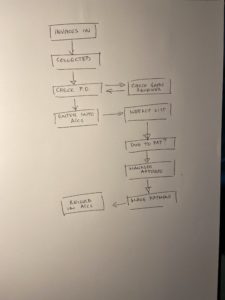Operational Efficiency – The First Steps
In my Small Business Owners Growth Guide, I identify the Six Business Success Factors.
In 40 years of working with small businesses, I have observed that all successful businesses do these 6 things well.
They are:-
- The Act of Leadership
- The Practice of Planning
- The Logic of Marketing
- The Pursuit of Customer Fulfilment
- The Attainment of Operational Efficiency
- The Mastery of Finance.
You can download my free Small Business Owners Growth Guide to the Six Business Success Factors here and “audit” your business to see how well developed they are in your business.
I’ve recently dealt with Leadership, Planning, Marketing and Customer Fulfilment in this blog, so this week I want to turn my attention to Operational Efficiency.
What do I mean by that?
I also want to set you a challenge that you can undertake over the next 5 days, taking just an hour a day to start your journey in Operational Efficiency.
Operational efficiency is about designing systems so that all the component parts of your business operate in the most efficient way possible, and that they all work seamlessly together.
Where you need Leadership in your business to inspire and motivate people so that they do better and work together toward a common goal, Operational Efficiency is about the “management” of the business – the details of what step comes before which.
Imagine a business where everyone knows what to do in every aspect of their work. They know how to do it, they know what to say to customers to deliver the goods, they know how to interact together so that they work seamlessly.
How easy would it be to manage?
How consistent would the work be?
How easy would it be to delegate?
How easy would it be to scale up?
Frankly, how easy would it be for you to take a vacation without worrying about the state of the business all the time?
Operational efficiency eliminates double-handling and unnecessary steps in any process.
It assumes, through good leadership, that everyone is clear about their role to drive the business toward ultimate big picture goals, and they all know how things are done there to do so.
It is based on written systems and procedures that will produce work that is efficient, replicable, consistent and scalable.
Now I have a challenge for you that you can undertake in just an hour a day for the next 5 days – are you game?
You can start this challenge on any day of the week, just break the sequence if the weekend is in the middle of your 5 days.
So let’s start with Day 1.
On Day 1, I’d like you to think of a process or responsibility that you urgently need to delegate or some part of the customer lifecycle that you urgently need to improve.
For most of us, when I say that written systems create efficiency, it makes sense and you agree.
But most of us feel overwhelmed at the thought of making it happen amongst the dozens, maybe even hundreds of separate processes that have been allowed to organically develop over the years. The idea of writing them down, let alone analysing the steps and improving them, is so time-consuming that you just don’t do it.
So, let’s just start with just one process.
Start with something urgent, where working on it takes care of both organising the urgent change as well as improving the process.
It may be a process or responsibility where someone is about to move on and someone else needs to be hired or moved into that job. This creates an urgency about recording what the process is.
Or, it may be some part of the customer lifecycle – acquisition, sale, delivery, after-sales service – that requires urgent attention because it is causing you sales or customers.
Choose your process and then take an hour to work on it – remember that while this may sound time-consuming, ultimately it saves you time. By creating a formal system you’re actually creating the opportunity to delegate the tasks or even automate them at a later stage. At the very least, it will make the change easier to implement and the quality of the outcomes will become predictable in future.
First, write a couple of sentences describing the process and what it is intended to achieve.
For example, you may have chosen the responsibility of ensuring that all supplier invoices are received and paid.
You might write:
“The objective is to ensure that we pay our suppliers on time when they are due. We should check that only correct and due invoices are accepted and paid.”
Then, take the rest of the hour to sketch out a map or flowchart (just a series of boxes and arrows) depicting the workflow, for example:-

On Day 2, you’ll possibly need a little help.
On Day 2, you’ll put aside an hour to write notes about your sketch of the process.
As you do this, you may need to get the help of various people who are involved in the process, just to make sure that what you think is happening is actually happening when they do it.
So, for example, you might end up with the following list of notes about the steps:-
- Invoices are emailed or received by mail.
- Whoever receives them must send them to Ruth, our Receptionist.
- Ruth will check with the order number to see that they match a Purchase Order.
- Ruth will then check with the person responsible that the goods were delivered and accepted.
- Ruth will get them to initial accordingly on the invoice and order so that we are sure they should be paid and not queried.
- Ruth will then send the initialled invoice to Tom our Purchase Order Clerk.
- Tom will enter them into our accounting system and file the invoice alphabetically in date order – they must be easy to find.
- Every week, Eve the Accountant will print a list of Accounts Payable and mark the due dates for payment – we don’t want to be late unless there is a reason.
- Eve will provide the suggested payment list to Florence the Manager who will sign the list if she agrees, and we know management has approved the payment.
- Eve will provide the approved list to myself who will set up payments through the bank system- if I have queries, I will speak to Florence.
It is easier to think about people when you record the steps. But once you have written all the steps, change the names of people into their position descriptions.
In this way, once written, the procedures can be applied by anybody in that position, even if they eventually leave, change, or are replaced.
You should try to be as detailed as possible and capture in your notes:-
- The steps in the order they should be taken.
- Position that is responsible for each step.
- The work involved in each step.
- What deadlines they have to work to.
- What the outcome of each step should be.
- If necessary, note how the evidence that a step has been taken should be recorded.
Day 3 will be one of analysis.
You only need up to an hour again.
Gather the people who are involved in the process and walk through the process as described. Ask the following questions:-
- Is this the way it is actually done in practice?
- Are you the right person to be doing the steps allocated to you?
- Do you have any special tricks or quirks in the process when you complete your part?
- Do you take any shortcuts?
- Is there any double-handling?
- Can we eliminate any steps while still meeting the objective (“pay correct and due invoices on time”)?
- Are there any unnecessary steps?
- Have you met a problem or bottleneck? How can we remove this?
- Is there a simpler way to process a step?
- Is there any other way we can improve this, while still meeting the objective?
In an hour’s discussion with the people who actually complete the task, you can design – or record as it is – an efficient process that can be followed by anyone in the future.
Day 4 – formalise the procedure.
On Day 4 you will write the procedure in such a way that it becomes “the way we do it here.”
You can download an example and template of a Policy & Procedure record to do this here – teikoh.com/P&P
Take an hour to transfer your steps and notes from Day 2 into a formal record and then discuss it with the people involved.
Making a consistent record of the procedure creates an orderly and formal way of recognising the “correct” way of doing the task.
It records the objective of the task – so you keep focus and don’t get lost in the detail – and it becomes a document that can be used to introduce a new person to the task, measure how well and efficiently you are doing the task, scale the task by adding more people or resources all doing the same thing, and allow you to delegate different aspects at any time.
Make sure everyone is able to access a copy of the procedure. A copy on a common drive in your computer system that everyone can access would do, or even a hard copy on a shelf that everyone can access.
Day 5 – watch and test the procedure.
You may not be able to schedule an hour to do this because the procedure may involve a few minutes of work through the day by various people.
However, as far as possible, try to trace the process fro start to finish.
Observe each person as they do their part of the task. Spend a few minutes asking them how they found it – is there anything that in practice they think could be improved?
At the end of the day, make any changes and republish the latest version.
That’s it!
In 5 days, you have chunked a part of your business systems and prepared a written procedure for that part. This starts you on your journey of Operational Efficiency.
You can now reproduce the process either one workflow at a time or plan a larger slice of dedicated time to work on a section of the systems.
You need not work on everything at once and you need not complete this redesign in an incredibly short time! So don’t stress!
As you work on and improve system after system, the improvements in efficiency will show, and they will have a knock-on effect.
In our example, imagine if the Receptionist was to leave the company – how much time is now saved in training a new person when you can simply hand them a procedure and show them where they can find the information about their responsibility? In improving the supplier invoice system, the knock-on effect is that you will also have improved the efficiency of training new staff.
So, knowing that the efficiency improvements will be felt and will stack one on the other, you can afford to make this process a continuing one and tackle each part of the business in time.
At the end though, remember that Operational Efficiency is one of six things you need to be good at if you want to build a successful business. To read about all of the Six Business Success Factors, you can download my free guide by clicking on this link teikoh.com/Guide
Go get it now!







No comments yet.
Add your comment